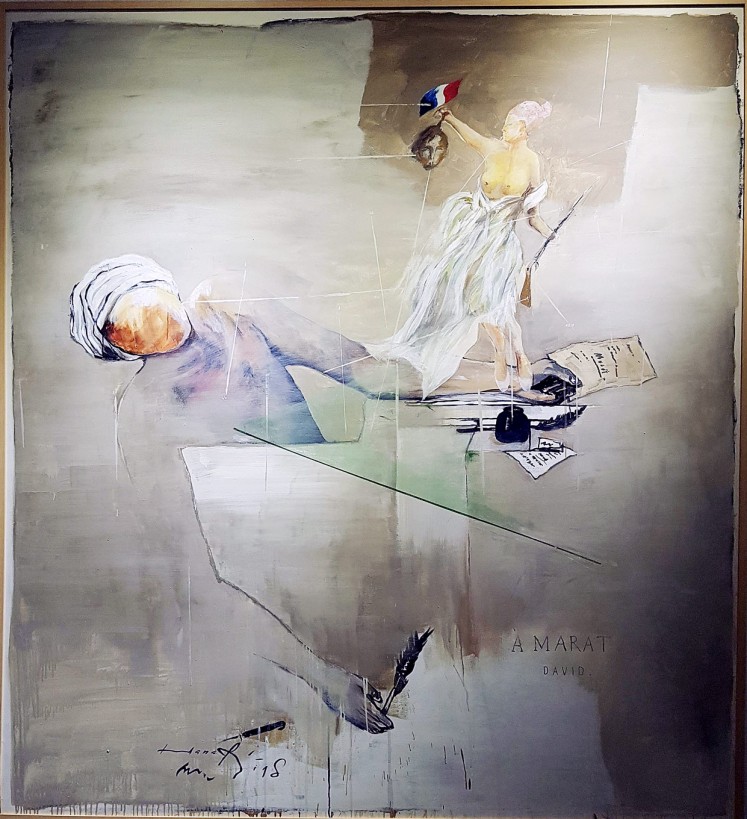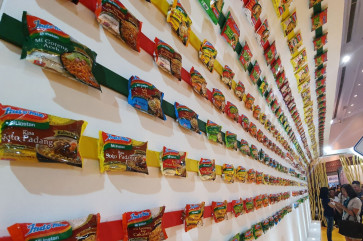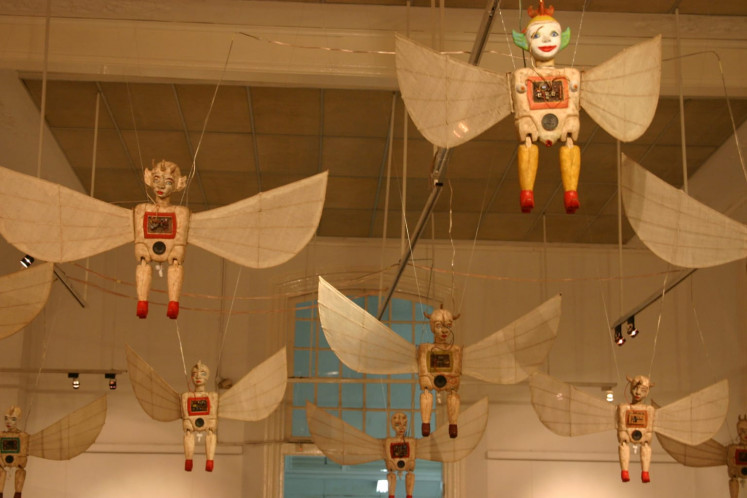Popular Reads
Top Results
Can't find what you're looking for?
View all search resultsPopular Reads
Top Results
Can't find what you're looking for?
View all search results'57 x 76': Responding to the mind's free nature
Two artists celebrate the beauty of subconscious response and the idea of deconstruction as an aspect that encourages transformation.
Change text size
Gift Premium Articles
to Anyone
H
eld at the National Gallery of Indonesia until July 2, the “57 x 76” exhibition is a showcase of artworks by legendary painter Hanafi and literary figure Goenawan Mohamad.
Working freely on shared canvasses, the slate allows the icons to convey and communicate with their partner through the subconscious shapes and colors that are drawn by their hand, with any idea coming into the fore accepted and then dealt with.
The exhibition’s title “57 x 76” refers directly to the artists’ ages, with Hanafi being 57 and Goenawan being 76. It is as much a celebration to the artistic flexibility of both men as much as it is a triumph over the adversities of age.
It is not the first time Goenawan has dabbled in the world of fine art. The founder of Tempo magazine claims he has taken part in such activities before, with an example being with the Sanggar Bambu collective of young artists in Yogyakarta.
Discussion: Goenawan Mohammad (left) and Hanafi talk about their exhibition during the press tour. (JP/Adeline Sunarjo)The artworks of “57 x 76” are not ones that exhibits the clash or showiness of artistic egos. This is commendable, considering that both men are highly respected, well-known creators in their field.
Both let go of their pretensions once they touched the canvass together. As a result, all ideas have room to flourish and develop into anything it wants to be, while no piece of art feels similar to another.
Considering this, is it really the grandiose egos of big-name artists that often drives the quality of their art down and make their process more vulnerable, usually when they’ve realized they’re the best?
Fortunately, this is not the case with the works of “57 x 76”. One cannot see only Hanafi or Goenawan in these works, and being the more skilled one, Hanafi’s strokes do not overshadow Goenawan’s efforts.
“During this collaboration, Hanafi and I rarely talked about concepts,” Goenawan said. “He would send me his parts of the piece with a certainty that it will not be ruined no matter what I add to it. It is an intuitive dialogue, rather than a direct one”.
There seems to be a dissipation of ego when these two multi-media figures work together, because of the process being built solely on calling and responding. One can only see their playfulness and mutual understanding toward each other’s thoughts as their ideas color and bring life and depth onto the canvasses, no matter how abstract or disjointed they are, and let them play freely like puppies.
In a way, there is no centerpiece to this exhibition. But maybe that is the point. Every stroke, shape or cultural reference is well blended together as if any remnants of one big idea would only exist as big as a small chunk.
“You can see it as if it is reading a novel from the middle pages,” added Hanafi. “Our works encourage the viewer to keep on figuring out the beginnings and the ends that are not shown directly to them. A canvass provides us with many doors to enter it, maybe more than a novel might have.”
Revolution: In one of the exhibited works, the artists pay tribute to the French Revolution. (JP/Adeline Sunarjo)These doors of perception are scattered throughout their paintings, although some doors are more visible and appear more frequently than others. For one, the faces and words of Pablo Picasso or Max Ernst feature prominently in several artworks, with Ernst particularly receiving significant tributes through elaborate pieces such as one tribute to Ernst’s 1920 painting The Horse, He’s Sick.
This piece is made up of two canvasses, one picturing the head and another the rear of a horse, of which are connected to each other by a wooden (or steel) form of a horse’s skeletal torso and a body that is merely spray painted onto the wall.
It is the closest thing the exhibition has to a centerpiece and is a prime example of the extent of the duo’s free, concept-less approach toward the deconstruction of ideas.
“The term ‘deconstruction’ for me is like a permission to metamorphose lines, shapes and colors. Hanafi’s works are usually monochromatic and his themes allude to his inspirations such as towards Ernst, Picasso and other surreal shapes,” said Goenawan.
“We welcome and wear these shapes on the canvas so as to always transform them.”














